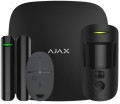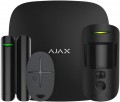Backup power
The time that the alarm is able to work on its own built-in power supply, in case of failure of an external power source.
Backup power allows the security system to remain operational during power outages (including during deliberate shutdown). The longer the time of operation on backup power, the more reliable the alarm, the lower the likelihood that due to power outages, the security will be completely disabled. At the same time, note that the specifications usually indicate an “perfect” battery life, with minimal power consumption; in fact, this period may be less — depending on the specific mode of operation, the frequency of operations and the quality of the batteries used (if replaceable batteries play the role of an autonomous source). So it is worth choosing according to this indicator with a certain margin — at least 15 – 20%.
Max. wireless sensors
The number of wireless sensors that can be simultaneously connected to the central unit (if this connection format is supported — see "Connecting sensors"). This number, by definition, is not less than the number of wireless zones (see the relevant paragraph).
Note that even the most modest modern systems support 6 – 8 wireless sensors, in the most advanced models this number can exceed 100. So you have to pay attention to this parameter mainly in cases where you need to organize a very extensive alarm system.
Users (numbers to call)
The number of users or voice call numbers that can be stored in the device's memory.
The very possibility of a call, of course, is found only in models with support for remote control — via GSM or Wi-Fi (see "Control"). Systems with this function, when triggered, send a voice call to specified users via the mobile network to a phone or via the Internet to an application on a smartphone / tablet. Having accepted the call, the user receives voice information about the details of the alarm, and also, in most cases, gets access to additional functions: control via the voice menu, intercom, listening (see "Control panel capabilities"), etc. Many modern alarm systems allow set not one recipient of such calls, but a whole list: if there is no connection with one user, the system will try to call the second, if he does not answer, the third, etc. This will be useful in cases where several people are responsible for signaling.
Control
Control methods provided in the set.
—
Keypad of the control panel. Keyboard control on the central unit. The simplest and most inexpensive method, which has long been used in alarms and is suitable for even the simplest low-cost-level kits. To access the controls, you need to be directly near the central unit — this can be both a disadvantage and an advantage, depending on the situation. So, it is not always convenient to approach the control panel every time; on the other hand, if remote control methods are not provided for in the design, the alarm system turns out to be as resistant to hacking as possible: it cannot be hacked remotely, and in order to physically get to the central unit, you usually need to overcome the protected perimeter.
—
Keychain. Controlled by a wireless remote control, similar to those used in car alarms. This method is quite convenient from a practical point of view: you can give alarm commands from a distance, and it is convenient to carry the key fob with you — for example, by attaching it to the same key ring that opens the protected room. The range of key fobs (see above) in modern alarms ranges from 40 – 50 m to 1.5 km or even more. The disadvantage of this option is the actual dependence on the key fob, which can be lost or stolen; and the batteries in the key fob also need to be monitored so as not to be left without a remote control at the most inopportune moment.
—
From the phone (GSM). Phone control via GSM networks. Note that you do not need a smartphone to use this function: control is carried out via SMS and/or voice menu and is available from any mobile phone, and in some models from a stationary phone with tone dialing. In addition to the ability to access the alarm from almost anywhere in the world where there is a mobile connection, this type of control has another important advantage: the design often provides for feedback, namely the ability to send voice calls and/or SMS messages to the user's phone (see Fig. "Users (numbers to call)", "Numbers to SMS"). However here it is worth considering that in order to use GSM control, it is necessary to buy and install a SIM card of a mobile operator in the central signaling unit; and for calls and SMS from the central office, the mobile operator will charge on a general basis.
—
From the Internet (Wi-Fi).... Management via the Internet — through an application on a computer or mobile gadget or through a special page in any browser; via Wi-Fi, in this case, the alarm is connected to the Internet. Like the mobile communication described above, this method makes it possible to control the alarm from anywhere in the world (if there is access to the World Wide Web), and receive various notifications from the alarm. Specific features of such management should be clarified separately. Among other things, this method is especially convenient for those who often travel abroad: mobile roaming on such trips is not cheap, it can be easier to find Internet access.Operating temperature
The air temperature range in which the alarm components maintain normal operation.
This parameter is important first of all in cases where the alarm is planned to be used outdoors or in unheated rooms. Particular attention in such cases should be paid to whether the system can work
at sub-zero temperatures. If we are talking about room temperatures (plus or minus), then you can’t really look at the claimed temperature range — almost any alarm is suitable for such conditions.
Max. humidity
The highest relative humidity at which the alarm is able to operate normally.
Excessive humidity leads to water settling on the system components, which can affect their performance and even lead to breakage. Therefore, modern electronics, including alarms, usually have limits on permissible humidity. However, you need to pay attention to this indicator mainly in cases where the kit is planned to be used outdoors or in rooms with initially high humidity, such as swimming pools or water parks — for such cases, it is desirable that the humidity limit be at least 90%. But in residential and office premises, humidity rarely exceeds 80%, and such conditions can endure almost all modern alarm systems.

